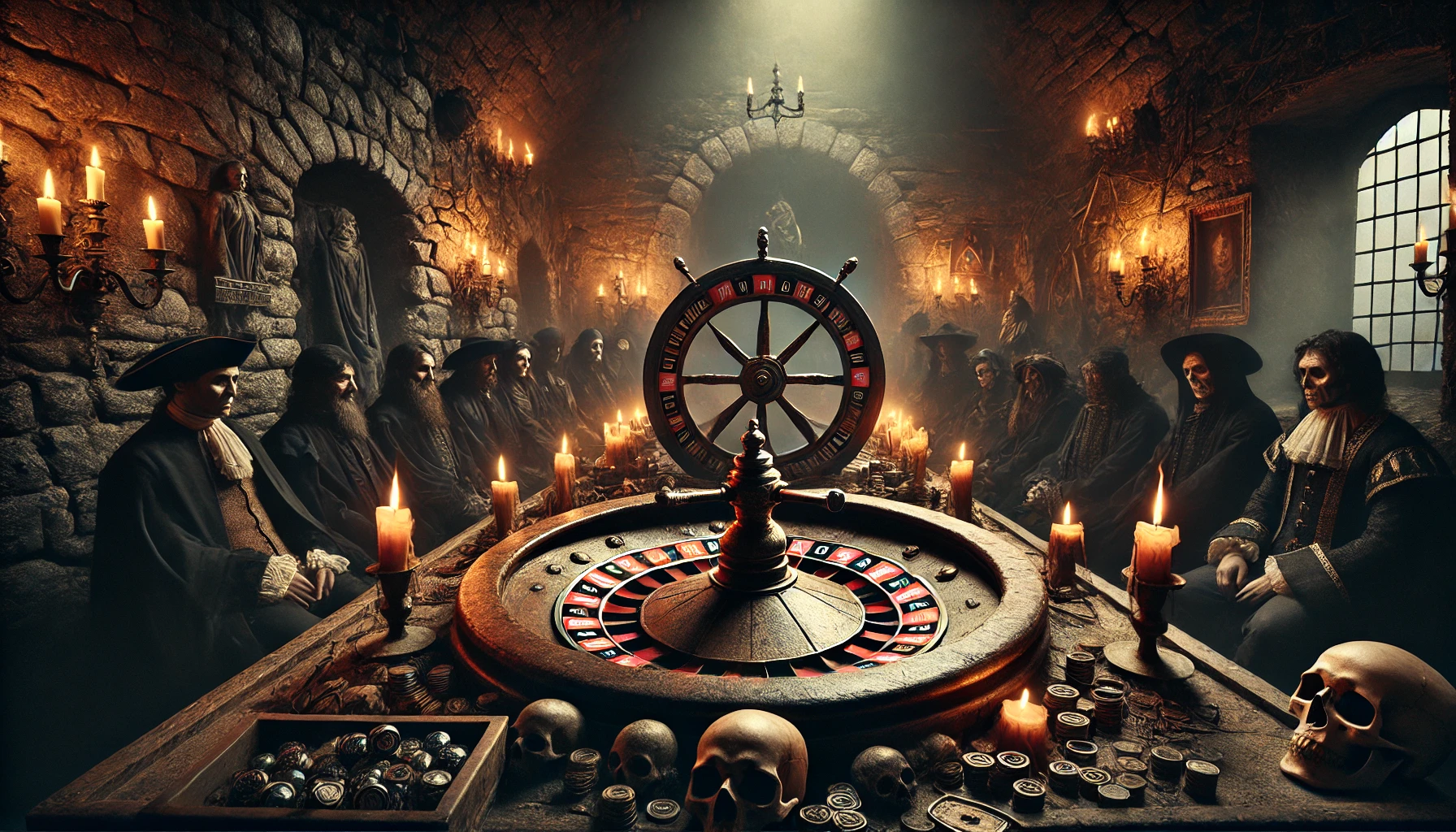The 17th century death roulette refers to a historical and often morbid game of chance that encapsulated the darker aspects of human nature and society during that time. This concept, while not a formal game, represented a societal fascination with mortality and the randomness of life and death.
In this context, “roulette” symbolizes a gamble with life, where participants would take risks that could potentially lead to fatal outcomes. Such activities were often influenced by the socio-political climate of the 17th century, characterized by wars, plagues, and existential uncertainty.
While death roulette may sound macabre, it served as a reflection of the human condition and the era’s attitudes toward fate, luck, and mortality. Understanding this historical phenomenon allows us to grasp the complexities of 17th-century life and the psychological implications of such games.
Overall, the 17th century death roulette provides a fascinating lens through which to examine societal values and fears of the time.
Historical Context of Death Roulette in the 17th Century
The historical context of death roulette is deeply rooted in the tumultuous events of the 17th century. This era was marked by significant turmoil, including the Thirty Years’ War, the English Civil War, and widespread disease, all of which contributed to a collective anxiety about life and death.
In times of crisis, people often turned to games and rituals as a means of coping with uncertainty. The idea of playing with fate, as embodied in death roulette, emerged as a way to confront the fears associated with mortality. This was a period when the value of life was often questioned, leading to a fascination with the randomness of existence.
Additionally, the cultural backdrop included a rich tapestry of philosophical and literary influences that explored themes of fate and chance. Writers and thinkers began to articulate the human experience as a series of unpredictable events, reinforcing the allure of death as a game.
Thus, the historical context of 17th century death roulette not only highlights societal fears but also reflects a deep philosophical inquiry into the nature of existence.
The Rules and Mechanics of 17th Century Death Roulette
While not formally codified, the 17th century death roulette operated on a set of informal rules and mechanics that varied by location and context. Typically, participants would engage in a game that involved making choices with potentially lethal consequences, often influenced by superstitions and local customs.
The mechanics often revolved around a spinning wheel or a similar device that determined outcomes, akin to modern games of chance. Players would place bets or make decisions based on the outcome of the spin, with certain outcomes leading to fatal consequences for the unlucky players.
Key Elements Included:
- Participants: Usually a group of individuals willing to take risks, often driven by a mixture of thrill and despair.
- Decisions: Players would make choices that could result in life or death, highlighting the randomness of fate.
- Consequences: Outcomes could vary widely, from benign results to deadly consequences, echoing the unpredictability of life.
Overall, the rules and mechanics of 17th century death roulette illustrated the era’s complex relationship with fate and mortality, blending chance with existential inquiry.
Notable Figures Associated with 17th Century Death Roulette
Several notable figures and social contexts have been associated with the concept of death roulette in the 17th century. While specific individuals may not be directly linked to this practice, various historical figures embody the spirit of risk-taking and the exploration of mortality.
For instance, military leaders and explorers of the time often engaged in risky endeavors, akin to a form of roulette with their lives. Their decisions in battles and explorations reflected a willingness to gamble with fate, paralleling the themes present in death roulette.
Additionally, writers and philosophers, such as Montaigne and Shakespeare, explored themes of chance and fate in their works. Their literary contributions helped shape public perception of risk and mortality, providing a cultural backdrop to the idea of death roulette.
Ultimately, the notable figures and their contexts serve to enrich our understanding of 17th century death roulette, linking the concept to broader themes of bravery, exploration, and the human condition.
Cultural Significance of Death Roulette in 17th Century Society
The 17th century death roulette held significant cultural importance, reflecting the era’s preoccupation with death, fate, and the human experience. In a time rife with war, disease, and social upheaval, this concept provided a lens through which people could confront their fears.
Engaging with the idea of death roulette allowed individuals to explore existential questions and the randomness of life. It served as a form of social commentary on the unpredictability of human existence, highlighting the fine line between life and death.
Moreover, the practice often influenced local customs and rituals, where games involving chance were integrated into social gatherings and festivities. This communal engagement fostered a shared understanding of mortality, making it a vital aspect of the cultural fabric of the time.
In essence, the cultural significance of 17th century death roulette lies in its ability to encapsulate the era’s anxieties while providing a form of catharsis through the exploration of fate.
Comparing 17th Century Death Roulette to Modern Games
Comparing 17th century death roulette to modern games reveals significant differences in context and purpose. While both involve elements of chance, modern games tend to focus more on entertainment and competition rather than the existential themes tied to mortality.
Today’s games, such as roulette in casinos, center around monetary stakes and thrill rather than life and death. Players engage for enjoyment, often detached from the deeper implications of their choices.
However, the underlying mechanics of chance remain consistent. Both death roulette and modern games involve risk, decision-making, and unpredictability, demonstrating humanity’s enduring fascination with the unknown.
Understanding these comparisons enriches our appreciation of how games have evolved over time, transitioning from existential explorations to forms of entertainment that reflect contemporary values.
The Influence of Death Roulette on Literature and Art
The concept of death roulette has left a mark on literature and art throughout history, particularly during the 17th century. Writers and artists explored themes of mortality, fate, and chance, often using the idea of roulette as a metaphor for the unpredictability of life.
Notable literary works of the time reflected these themes, portraying characters grappling with their fates in ways reminiscent of a game of chance. This exploration deepened the cultural discourse surrounding death and existence, making it a compelling subject for artistic expression.
Artists also depicted scenes of chance and risk in their works, capturing the emotional weight of living on the edge. These representations served to challenge viewers’ perceptions of mortality and the randomness of human experiences.
Overall, the influence of death roulette on literature and art highlights the interconnectedness of creativity and existential inquiry, shaping cultural narratives about life and death.
Psychological Aspects of Participating in Death Roulette
The psychological aspects of participating in death roulette are profound, reflecting the human fascination with risk and mortality. Engaging in such a game often evokes a mix of thrill and fear, as players confront their vulnerability and the uncertainty of outcomes.
For many, the allure of participating in death roulette stems from the desire to explore the boundaries of existence. This attraction to risk can be seen as a form of escapism, allowing individuals to grapple with their fears in a controlled environment.
Additionally, the social dynamics involved in death roulette can influence psychological experiences. The communal aspect of engaging in high-stakes decisions may foster a sense of camaraderie, while also amplifying the emotional stakes involved.
In summary, the psychological aspects of death roulette reveal deep-seated human tendencies to confront mortality, seek thrills, and navigate complex social interactions.
Controversies Surrounding 17th Century Death Roulette
The practice of 17th century death roulette was not without its controversies, particularly given its ties to risk-taking and the potential for fatal consequences. Critics often viewed such games as reckless, questioning the morality of gambling with life itself.
Many argued that engaging in death roulette reflected a disturbing aspect of human nature, where the thrill of chance overshadowed the value of life. This perception led to debates about the societal implications of such practices and their impact on community values.
Additionally, authorities and religious figures frequently condemned games involving death, viewing them as sinful or morally questionable. This societal backlash contributed to the complexity of the cultural landscape surrounding death roulette.
Overall, the controversies associated with 17th century death roulette highlight the tension between human curiosity and societal norms regarding mortality and risk.
The Legacy of 17th Century Death Roulette Today
The legacy of 17th century death roulette persists in contemporary culture, particularly in how we engage with themes of chance, risk, and mortality. While the practice itself may not exist in the same form, its essence can be seen in various aspects of modern gaming and entertainment.
Today, the fascination with risk-taking remains prevalent, whether in gambling, extreme sports, or reality television. These activities echo the sentiments of death roulette, inviting participants to confront the unknown in thrilling ways.
Additionally, the philosophical inquiries prompted by death roulette continue to resonate in literature and art. Modern creators often explore similar themes, reflecting humanity’s enduring struggle with the concepts of fate and existence.
In conclusion, the legacy of 17th century death roulette serves as a reminder of our complex relationship with risk and mortality, shaping cultural narratives that persist into the present.
How Death Roulette Reflects the Attitudes Toward Life and Death
Death roulette serves as a compelling reflection of societal attitudes toward life and death in the 17th century. The very act of gambling with one’s fate highlights the tension between the desire for control and the acceptance of uncertainty.
During this era, individuals often grappled with existential questions in light of widespread conflict and disease. Engaging in death roulette allowed participants to confront their fears and consider the fragility of existence in a visceral way.
This reflection on mortality also sparked philosophical discussions about the meaning of life and the role of chance. The willingness to risk one’s life for the thrill of the game underscores a complex relationship with death that was both fearful and intriguing.
Ultimately, death roulette encapsulates the duality of human experience, revealing how societies navigate the delicate balance between living fully and acknowledging the inevitability of death.
Final Thoughts on the Fascination with 17th Century Death Roulette
The fascination with 17th century death roulette stems from its rich interplay of risk, mortality, and human psychology. This historical concept continues to intrigue scholars, gamers, and enthusiasts alike, as it encapsulates deep philosophical questions about existence.
Understanding the motivations behind such practices offers valuable insights into the human condition, illustrating our desire to confront fear and uncertainty. As modern society grapples with similar themes in various forms, the legacy of death roulette remains relevant.
In conclusion, the exploration of 17th century death roulette invites us to reflect on our own relationship with chance and mortality. By studying this historical phenomenon, we can gain a deeper appreciation for the complexities of life and the enduring allure of the unknown.

